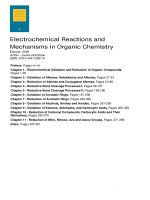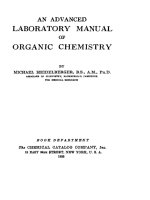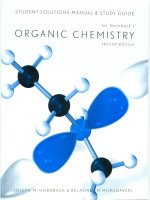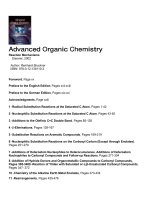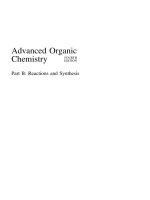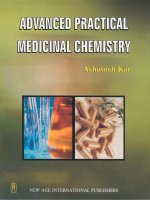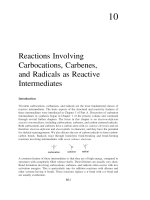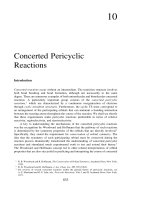Preview Advanced Organic Chemistry (Structure Mechanisms) by Ashutosh Kar (2017)
Bạn đang xem bản rút gọn của tài liệu. Xem và tải ngay bản đầy đủ của tài liệu tại đây (49.97 MB, 100 trang )
Advanced
Organic
Chemistry
(Structure & Mechanisms)
i
Other Related Titles in Chemistry
Handbook of Chemical Industries
P. Vishwanathan
Chemical Thermodynamics
P. Vishwanathan
Chemistry for Chemical Industries
P. Vishwanathan
Introduction to Polymer Science and Technology
D.K. Sharma
Textbook of Physical Chemistry (Part 2nd & 3rd)
J. Lahiri
Advanced Organic Chemistry
Ashutosh Kar
Practical Manual of Biochemistry
Sadhana Sharma, Reema Sharma
Concept of Physical Chemistry
Jyotirmay Lahiri
Textbook of Pericyclic Reactions
K.C. Majumdar, Paritosh Biswas
Textbook of Engineering Chemistry
Deepa Sharma
Organic Chemistry
Gene A. Davis, Ph. D.
Organic Synthesis Through Disconnection
Approach (2nd Edition)
P.S. Kalsi
Engineering Chemistry
Friedrich Emich
Water Chemistry
Mark M. Benjamin
Textbook of Chemical Engineering — Vol. 1
Vikas Zaveri
Textbook of Chemical Engineering — Vol. 2
P. Vishwanathan
Advanced
Organic
Chemistry
■
■
■
■
■
(Structure & Mechanisms)
-
.
•
.
:
.
.
'
.
.
.
■
.
[For B.Sc. (Hons.), M.Sc, and Research Scholars]
Ashutosh Kar
Professor Emeritus, Lingaya's University, Faridabad (India)
Formerly
Professor, School of Pharmacy, Addis Ababa University,
Addis Ababa (Ethiopia)
Dean, Chairman & Professor, Faculty of Pharmaceutical Sciences,
Guru Jambheshwar University, Hisar (India)
Professor, School of Pharmacy, Al-Arab Medical University,
Benghazi (Libya)
Professor & Head, Department of Pharmaceutical Chemistry,
Faculty of Pharmaceutical Science, University of Nigeria,
Nsukka (Nigeria)
Professor & Head, Department of Pharmaceutical Science,
College of Pharmacy, Delhi University, New Delhi.
m
MEDTECH
Engaging Sciences—Developing Minds!
"QUOTES"
"One. 3mpaxtant 3ieu to- Succeed
3s Sety-Confidence.
On Smpoxtant 3Ceu to- Self-Cenfidence
3s 3>iepevuUion"
— A R T H U R ASLIE
"She 3utwte tBdomp to- Jhase—
Who- Relieve in the {Beauty, of, Jhevc Steams."
—EIEAINOR ROOSEVEIT
"2)*eams WM Only 3tetp %oa actualize %ewt QOOIA.
3 Started 3)xeantina When 3 was a QMd
3 {Became a Scientist {Because 3 IDteamt"
—APJ Abdul KAIAM
TCttotuiedqe 'SeqeU 24faie*te(f,
V
Jo ^nu
HAouzd
'Jo Otbxi
JV{z Butfd-uf> J\f[ij
(Dux ^ 0 / 2 1 , J^auqhtsxi-in-Laur
^biistzxi and
Sxotnzx
and &V\y
\Paietm,
^\L
^Hy
and
Hifs vrittgoi)
— itismsd
1'ift,
Je.acns.xi and
{ffxandcnddxzn
and
C&uu
Jauanti.
(in Undla,
Ctnlokia)
Jo
and <^rfbxoad,
the. ^rf-uauit
cJrutlioxi-cTio/m
tL Book O
Jo
JL
{Psofde
Jo
Jtta&t
l C J\AetiaIoudi)
JxuitfuftL
\JOX C.vtx and
Jo
f
Salt,
JVour,
cJrLniiaktu (flod i £.t£.xnal
0 Jx'tl/itctfull'y
JolL
jDLeiiinai,
S o a r , Bocir and !BOUJ.
vii
Preface
T
he fundamentals of Organic Chemistry may be understood in a comprehensive manner only
through three important channels that would ultimately open up the scope of this branch of
chemistry into a leading subject of choice, creativity, and versatility amongst the students,
researchers and scientists alike. First, it would be mandatory for one to get adequately familiarized
with the physical and chemical properties of the Organic Chemical Entities (compounds). Secondly,
one would understand critically their reactivities together with their inherent options and/or intricacies
of various range of reactions. Thirdly, it would be an absolute must to develop the enormous ability
to Design Synthesis in a big way with knowledge, wisdom, skill, intellect, perseverance and above
all the dogged determination.
The students of present generation opting to study chemistry do often experience a significant
drawback perhaps caused by an overwhelming growth and advancements taken place in all the
sciences that are accompanied specifically by the students of Organic Chemistry to muster, learn
and adapt to a relatively huge number of reactions that was never a situation previously.
A survey of literature would certainly ascertain the underlying fact that older concepts, ideas
and knowledge are being transformed rapidly by: Modern methodologies, theories, innovation of
ideas/thoughts, newer scientific observations and a virtual war on revolution in the advancement in
the domain of Organic Chemistry. It essentially comprises: Orbital Theories, Wave Mechanics,
Combinatorial Chemistry, Chiral Chemistry, 3D-NMR Techniques, FTIR-Spectroscopy, X-Ray
Diffraction (XRD) Analysis, Optical Rotary Dispersion (ORD) Studies, HPLC-Analysis, LC-MS/
GC-MS/IR-MS Hyphenated Methods, CADD-Methods, and the like, which have rendered the Organic
Chemistry into an obvious 'World of Science' itself.
The textbook on Advanced Organic Chemistry has been written integrity, passion and a
mission to make it into a student-friendly campanion for the M.Sc, B.Sc. (Hons.), and Research
Scholars pursuing for Ph.D. programmes.
For the benefit of brilliant students in the Indian Universities and abroad as well—the entire
textual matter has been arranged meticulously into Twenty-Five Chapters contained in Five Sections
(1, 2, 3, 4 and 5)—as stated under:
ix
X
PREFACE
Part A : Fundamentals of Organic Chemistry [Chapters 1 to 3];
Part B : Name Reactions Based on Product Formed [Chapter 4 to 11];
Part C : Rearrangements : Classifications and Mechanisms [Chapters 12 to 19];
Part D : Organic Reactions and Mechanisms [Chapters 20 to 24], and
Part E : Some Novel Reactions in Organosilicon Chemistry [Chapter 25].
The major strengths of the textbook have been developed carefully starting each chapter with :
a brief introduction, fundamentals of organic reactions, reaction mechanisms, classical examples,
nomenclature of reactants and mechanisms to enable the readers to grasp the in-depth of Organic
Chemistry, followed by footnotes, references on each page (wherever required) and other relevant
references under Suggested Reading at the end of each chapter.
The esteemed readers will be benefited grossly with vital divergent aspects of Advanced
Organic Chemistry with particular reference to such critical areas of interest as given below:
• Atomic Bonding • Stereochemistry • Reaction Intermediates • Factors Governing Reactivity
Profile • Rearrangements in Organic Chemistry Related to : Electron Deficient Heteroatoms—Acyl
Carbenes—Induced by Electron-rich sites—Addition-Elimination Mechanism—Pericyclic Reactions—
Aromatic Rearrangements—Scope and Mechanism of Substitution Reactions—Addition Reactions—
Elimination Reactions; and Novel Reactions in Organosilicon Chemistry.
Special attention has also been paid to all the aspects of synthetic processes included in the text
matter.
It is believed earnestly that the present compendium would certainly prove to be an asset and
a reliable source of authentic information(s) not only to the students but also to the valued teachers
dealing with the subject.
The author would like to place on record the excellent help and candid cooperation from Shri
Rajan Jain, Director, Scientific International (Pvt) Ltd., New Delhi, in bringing out the book in a
scheduled time-frame.
Gurgaon (India)
Ashutosh Kar
Contents
Section 1
FUNDAMENTALS OF ORGANIC CHEMISTRY
1 Atomic Bonding
1.1 Introduction
1.1.1 Covalent Bonding
1.1.2 General Methods of Approximation
1.1.3 Variants in Molecular Orbital Procedure
1.2 The Valence-Shell Electron-Pair Repulsion [VSEPR] Theory
1.3 Metallic Crystals
1.3.1 Guiding Factors Governing the Formation of Metallic Bond
1.3.2 Nature of the Metallic Bond
1.3.3 Certain Physical Characteristic Features of Metals vis-a-vis their
Explanations Based Upon Electron-Gas Theory
1.4 Hydrogen Bond
Suggested Reading
2 Stereochemistry
3-5
1
1
1
1
21
31
31
31
4
4
5
53-9
2.1
2.2
2.3
2.4
Introduction
Isomerism
Stereoisomerism
Characteristic Features of Enantiomers: Optical Activity
2.4.1 The Plane-Polarized Light
2.4.2 The Polarimeter
2.4.3 Specific Rotation
2.4.4 Genesis of Optical Activity
2.5 Various Recognized Projection Structures of Stereoisomers
2.5.1 Fischer's Projection of Enantiomers
2.5.2 Flying-Wedge Representation
2.5.3 Sawhorse Projection
2.5.4 Newman Projection Formula
2.6 Simple Molecules: Hybridization, Conformation and Configuration
2.6.1 Hybridization
2.6.2 Conformation
2.6.3 Configuration
Suggested Reading
3 Reaction Intermediates and Factors Governing Reactivity
3.1 Introduction
3.2 Carbocations [or Carbonium Ion]
3.2.1 Classification of Carbocations
3.2.2 Formation of Carbocations
3.2.3 Stability Profile of Carbocations
3.2.4 Actual Structure of Carbocation
5
5
5
5
6
6
6
6
6
6
6
6
7
7
7
8
9
9
98-14
9
9
9
10
10
10
xi
xii
CONTENTS
3.3 Carbanions
3.3.1 Classification of Carbanions
3.4 Free Radicals
3.4.1 Structure of Free Radicals
3.4.2 Formation of Free Radicals
3.5 Stereochemistry of Radical Substitution Reactions
3.6 Carbenes
3.7 Nitrenes (Imidogenes)
3.8 Arynes (Benzynes)
3.9 Factors Governing the Reactivity Profile
3.9.1 Electronic Effect
3.9.2 Inductive Effect [or Transmission Effect or I-Effect]
3.9.3 Mesomeric Effect
3.10 Hyper Conjugation
3.10.1 Theories of Hyperconjugation
3.10.2 Variants in Hyperconjugation
Suggested Reading
10
10
11
11
11
12
12
12
13
13
13
13
13
13
14
14
14
Section 2
NAME REACTIONS BASED ON PRODUCT FORMED
4 Reactions Giving Carbonyl Compounds
149-20
5 Reactions Giving Alcohol—Hydroxy Carboxylic Acid and Phenols
201-22
6 Reactions Giving Arenes
226-23
4.1 Introduction
4.1.1 Aldol Condensation
4.1.2 Gattermann Synthesis [or Gattermann Aldehyde Synthesis]
4.1.3 Rosenmund Reduction
4.1.4 Sommelet Reaction
4.1.5 Baker; Mahal et al. Reaction
4.1.6 Carroll Rearrangement
4.1.7 Nef Reaction
4.1.8 Robinson Annulation
4.1.9 Friedel-Craft's Acylation
4.1.10 Mannich Reaction
4.1.11 Dickmann Condensation Reaction
Suggested Reading
5.1 Introduction
5.2 Detailed Treatment of Various Name Reactions and Rearrangements
5.2.1 Meerwein-Ponndorf-Verley Reduction [Aluminium Alkoxide Reduction]
5.2.2 Blanc Chloromethylation [Blanc Reaction]
5.2.3 Brown Hydroboration
5.2.4 Cannizzaro Reaction
5.2.5 Nozaki-Hiyama-Kishi Reaction [Nozaki-Hiyama Coupling Reaction]
5.2.6 Oppenauer Oxidation
5.2.7 Grignard Reaction
5.2.8 Evans-Aldol Reaction
5.2.9 Dienone-Phenol Rearrangement
5.2.10 Bomberger Rearrangement
Suggested Reading
6.1 Introduction
6.2 Friedel-Crafts Alkylation Reaction
6.3 Benzoin Condensation
Suggested Reading
".
14
15
16
17
17
17
18
18
18
18
19
19
20
20
20
20
20
20
20
21
21
21
22
22
22
22
22
22
23
23
CONTENTS
7 Reactions Giving Saturated and Unsaturated Hydrocarbons
7.1 Introduction
7.2 Divergent Reactions Giving Saturated and Unsaturated Hydrocarbons
7.2.1 Birch Reduction
7.2.2 Clemmensen Reduction
7.2.3 The Chugaev Reaction [Tschugaeff Olefin Synthesis]
7.2.4 Cope Elimination Reaction [Cope Reaction]
7.2.5 Hoffmann Elimination Reaction [Hoffmann Degradation]
7.2.6 Kolbe Electrolytic Reaction [Kolbe's Electrooxidation]
7.2.7 McMurry Coupling [McMurry Reaction; De-Oxygen-Coupling]
7.2.8 The Peterson Olefination Reaction
7.2.9 Shapiro Reaction
7.2.10 Wolff-Kishner Reduction (Huang-Minion Modification)
7.1.11 Ziemmermann Rearrangement (Di-7i-Methane Rearrangement)
Suggested Reading
8 Reactions Giving Carboxylic Acids and its Derivatives
8.1 Introduction
8.2 Name Reactions: Giving Carboxylic Acids and its Derivatives
8.2.1 arzen Condensation [or Darzen-Glycidic Ester Condensation]
8.2.2 Kolbe-Schmitt Reaction
8.2.3 Knoevenagel Condensation Reaction [Conjugated Carboxylic Acid]
8.2.4 Michael Addition Reaction [Michael Condensation]
8.2.5 Perkin Reaction
8.2.6 Reformatsky Reaction [Reformatskii Reaction]
8.2.7 Stobbe Condensation
8.2.8 Yamaguchi Esterification [Yamaguchi Macrolactonization]
Suggested Reading
9 Reactions Giving Heterocyclic Compounds and its Derivatives
9.1 Introduction
9.2 Reactions Giving Heterocyclic Compounds and its Derivatives
9.2.1 Bartoli Reaction [Bartoli-Indole Synthesis]
9.2.2 Bischler-Napieralski Reaction
9.2.3 Chichibabin Reaction [Amination of Nitrogen Heterocycles]
9.2.4 Fischer Indole Synthesis
9.2.5 Hegedus Indole Synthesis
9.2.6 Paterno-Biichi Reaction [Photoaddition of Alkenes to Carbonyl Compounds]
Suggested Reading
xiii
237-26
23
23
23
24
24
24
24
25
25
26
26
26
26
26
270-30
27
27
27
27
27
28
29
29
30
30
30
309-32
30
31
31
31
31
31
32
32
32
10 Reactions Giving Halogen Derivatives
330-35
11 Miscellaneous Organic Reactions
352-39
10.1 Introduction
10.1.1 Radical Halogenation of Hydrocarbons
10.2 Reactions Giving Halogen Derivatives
10.2.1 Haloform Reaction
10.2.2 Hell-Volhard-Zelinsky Reaction [HVZ-Reaction]
10.2.3 Hunsdiecker Reaction [or Borodine-Hunsdieker Reaction]
10.2.4 Hydroboration (or Hydroboronation) Reaction
10.2.5 Wohl-Ziegler Bromination
Suggested Reading
11.1 Introduction
11.2 Miscellaneous Organic Reactions
11.2.1 Bucherer Reaction
11.2.2 Chapman Rearrangement
33
33
33
33
33
34
34
34
35
35
35
35
35
CONTENTS
11.2.3 Claisen Ester Condensation (The Claisen Condensation, The Synthesis of P-Keto Esters) 356
11.2.4 Diazo Coupling Reactions (Coupling Reactions of Arene-diazonium Salts)
36
11.2.5 The Diels-Alder Reaction
36
11.2.6 Fischer Oxazole Synthesis
37
11.2.7 Gabriel Synthesis [or Gabriel's Phthalimide Synthesis]
37
11.2.8 Overmann Rearrangement
37
11.2.9 Sharpless Epoxidation
38
11.2.10 Smiles Rearrangement (Truce-Smiles Rearrangement)
38
11.2.11 The Ulmann Reaction (De-Halogen Coupling)
38
11.2.12 Wolff Rearrangement
38
Suggested Reading
38
Section 3
REARRANGEMENTS: CLASSIFICATION AND MECHANISM
12 Rearrangements Induced by Cationic or Electron Deficient Sites (Carbon)... 393-410
12.1 Introduction
12.2 Name Reactions Based on Rearrangements Induced by Cationic or Electron
Deficient Sites
12.2.1 Pinacol Rearrangement
12.2.2 Tiffeneau-Demjanov Rearrangement
12.2.3 Wagner-Meerwein Rearrangement
12.2.4 Allylic Rearrangements
Suggested Reading
39
39
39
40
40
40
41
13 Rearrangements Related to Electron Deficient Heteroatoms
411^44
14 Rearrangements Related to Acyl Carbenes
441-44
15 Sigmatropic Rearrangements
450-47
13.1 Introduction
13.2 Rearrangements Related to Electron Deficient Heteroatom
13.2.1 Rearrangement Related to Electron Deficient Cationic Oxygen
13.2.2 Rearrangement Related to Electron Deficient Cationic Nitrogen
Suggested Reading
14.1 Introduction
14.2 The Criegee Rearrangement
Suggested Reading
15.1 Introduction
15.2 General Survey of Sigmatropic Rearrangement
15.3 [1,3]-, [1,5]-, and [l,7]-Sigmatropic Shifts of Hydrogen and Alkyl Moieties
15.3.1 The Computatinal Characterization of Transition Structures for [1,3]-, [1,5]-,
and [l,7]-Sigmatropic Shifts
15.3.2 Typical Examples of Sigmatropic Shifts of Hydrogen and Alkyl Moieties
15.4 Overview of [3,3]-Sigmatropic Rearrangement
15.4.1 Claisen Rearrangement
15.4.2 Cope Rearrangements
15.4.3 [3,3]-Sigmatropic Rearrangement in Triene Systems Containing Oxygens
15.4.4 [3,3]-Sigmatropic Rearrangement of Trienes Containing Nitrogen
15.4.5 [2,3]-Sigmatropic Rearrangements
Suggested Reading
16 Rearrangements Influenced by Stong Bases [and/or] Electron Rich Sites
16.1 Introduction
16.2 Various Rearrangements Based on Carbonyl Moiety
16.2.1 Benzylic Acid Rearrangement
16.2.2 Favorskii Rearrangement
41
41
41
41
44
44
44
44
45
45
45
45
45
46
46
46
46
46
47
473-50
47
47
47
47
XV
CONTENTS
16.2.3 Neber Rearrangement
16.2.4 Stevens Rearrangement
16.2.5 Wittig Rearrangement [or Wittig Reaction]
Suggested Reading
17 Rearrangements due to Addition-Elimination Mechanism
17.1
17.2
17.3
17.4
Introduction
Grob Rearrangement (or Grob Fragmentation)
Payne Rearrangement
Sommelet-Hauser Rearrangement
Suggested Reading
18 Rearrangements in Pericyclic Reactions
18.1 Introduction
18.2 Concerted Pericyclic Reactions
18.2.1 Cycloaddition Reactions
18.2.2 The Diels-Alder Reaction
18.3 Claisen Rearrangement
18.3.1 Preparation of Allyl Enol Ethers
18.3.2 Applicability of Allyl Vinyl Ethers/Allyl Ethers of Enols
18.3.3 Represents a Concerted Process
18.3.4 Oxa-Version of the Cope Rearrangement
18.4 Cope Rearrangement [or Oxy-Cope Rearrangement]
Suggested Reading
19 The Aromatic Rearrangements
19.1
19.2
19.3
19.4
Introduction
Benzidine Rearrangement
Fries Rearrangement
Reimer-Tiemann Reaction
Suggested Reading
48
48
49
50
502-50
50
50
50
50
50
508-53
50
50
51
51
52
52
52
52
52
53
53
534-54
53
53
53
54
54
Section 4
ORGANIC REACTIONS AND MECHANISMS
20 Substitution Reactions
545-58
21 Elimination Reactions
589-60
20.1 Introduction
20.2 Substitution Reaction Variants
20.2.1 Nucleophilic Aliphatic Substitution
20.2.2 Nucleophilic Aromatic Substitution
20.2.3 Electrophilic Aliphatic Substitution
20.2.4 Electrophilic Aromatic Substitution
20.2.5 Free Radical Substitution Reaction
20.2.6 Neighbouring Group Participation
Suggested Reading
21.1 Introduction
21.1.1 Dehydrohalogenation
21.1.2 Dehydrosulphonation
21.1.3 Eliminations of Quaternary Ammonium Hydroxides
21.2 Elimination Reaction Variants
21.2.1 p-Elimination Reactions—Unimolecular [or El-Elimination]
21.2.2 P-Elimination Reactions—Bimolecular [or £2-Elimination]
Suggested Reading
54
54
54
56
57
57
58
58
58
58
59
59
59
59
59
59
60
xvi
CONTENTS
22 Electrocyclic Reactions
608-621
2 3 Thermodynamics of Organic Reactions
622-633
24 Addition Reactions
634-654
22.1
22.2
22.3
22.4
23.1
23.2
23.3
23.4
23.5
Introduction
Interconversions of Dimethyl Cyclohexadienes and 2,4,6-Octatrienes
Thermal Cyclization of Substituted Butadienes
Electrocyclic Reactions in Organic Synthesis
Suggested Reading
608
610
615
620
621
Introduction
Kinetic vs Thermodynamic Control of Product Composition
Kinetic Profiles of Organic Reactions
Effect of Catalyst Upon the Kinetics of Reaction
Kinetic Control vs Thermodynamic Control of a Typical Chemical Reaction
Suggested Reading
622
623
627
628
629
633
24.1 Introduction
24.2 Electrophilic Addition Reactions [Addition of Hydrogen Halides (HX) to Alkenes]
24.2.1 Mechanism and Markovnikov's Rule
24.3 Nucleophilic Addition Reactions to Alkenes and Alkynes
24.3.1 Mesomeric Delocalization
24.3.2 Negative Inductive Effect
Suggested Reading
634
634
635
647
648
648
654
Section 5
SOME NOVEL REACTIONS IN ORGANOSILICON CHEMISTRY
25 Accelerated Organic Synthesis with Organosilicon Compounds
657-690
25.1 Introduction
25.1.1 Aims and Objectives
25.1.2 Selection Criteria for Silylating Agents
25.1.3 The Taft Equation
25.1.4 Applications of Taft's Parameter
25.2 Organosilicon Polymers
25.3 Comprehensive Account on Accelerated Organosynthesis with Organosilicon Compounds
25.3.1 Allylsilanes and Related Nucleophiles
25.3.2 Enantio Selective Allylation
25.3.3 Extended Allylsilane Chemistry
25.3.4
[3 + 2] Annulation Approaches
25.3.5
Organosilanes in Cross-Coupling Reactions
25.3.6 The Brook Chemistry [Brook Rearrangement]
25.3.7
Biological Applications of Organosilanes
Suggested Reading
APPENDICES
Appendix 1.
Appendix 2.
Appendix 3.
Appendix 4.
Appendix 5.
Appendix 6.
Appendix 7.
Appendix 8.
Appendix 9.
Appendix 10.
Glossary
Substitutive Nomenclature of Organic Compounds
Infrared Absorptions of Organic Compounds
Proton NMR-Chemical Shifts in Organic Compounds
13
C NMR Chemical Shifts in Organic Compounds
Summary of Synthetic Methods
Reactions Used to Form Carbon-Carbon Bonds
Typical Acidities and Basicities of Organic Functional Groups
Claisen and Cope Related Rearrangements
Abbreviations Used in Claisen and Cope Related Rearrangements
Index
657
658
659
660
661
662
665
665
666
673
676
679
683
686
689
691-749
693
720
722
725
728
730
735
736
739
746
751—772
Section 1
Fundamentals of Organic Chemistry
Chapter 1. Atomic Bonding
Chapter 2. stereochemistry
Chapter 3. Reaction intermediates and Factors
Governing Reactivity
Chapter
i
Atomic Bonding
LESSON AT A GLANCE
1.1 Introduction
1.1.1 Covalent Bonding
1.1.2 General Methods of Approximation
1.1.3 Variants in Molecular Orbital Procedure
1.2 The Valence-Shell Electron-Pair Repulsion [VSEPR] Theory
1.3 Metallic Crystals
1.3.1 Guiding Factors Governing the Formation of Metallic Bond
1.3.2 Nature of the Metallic Bond
1.3.3 Certain Physical Characteristic Features of Metals vis-a-vis their Explanations Based
Upon Electron-Gas Theory
1.4 Metallic Crystals
1.1 INTRODUCTION
What is an 'Atom'? The 'atom' relates to the smallest unit of an element that can exist. In fact,
'atoms' have long been known to be made up of subatomic paniculate matters invariably termed as:
• Protons
• Neutrons
and
• Electrons
The nucleus of an atom contains one or more proton, which are positively charged; and two
or more neutrons (except in hydrogen), which critically bears no electric charge. Besides, each
proton and neutron has a mass number of 1; and they are bound together so intimately in the
nucleus by means of the so-called exceedingly strong forces.
The electrons do move around the nucleus in shells (groups of orbitals) that are eventually
determined by their inherent:
• energy levels or
• wave functions
Thus, an electron happens to be a negatively charged unit that more or less behaves as both
• a particle (viz, partly wave), and
4
ADVANCED ORGANIC CHEMISTRY
NOTE:
Importantly, every atom has the same number of electrons as protons, and is thus 'neutral'
electrically.
Covalent Bond
The covalent bond refers to "a chemical bond resulting from the sharing of a pair of electrons
by two atoms, each atom donating one electron from its outer shell (bond energy ~ 100 kcal.
mole"1)."
In other words, the 'covalent bond' is duly formed by the sharing of electrons; and, therefore,
it would be quite possible to regard the critical sharing of two electrons by the aid of two atoms for
the making of a chemical bond. In addition, the atoms is capable of sharing one, two or three
electrons thereby giving rise to the formation of:
• a single (—) bond
• a double ( = ) bond and
• a triple ( = ) bond
Salient Features: These essentially include:
1. The electrons do have the same spatial energy as well as distribution profile*, but they
actually differ in their respective 'spin' according to the Pauli's exclusion principle.**
2. In a broader perspective, the electrons in an atomic nuclei predominantly occupy:
• orbitals of fixed energy and spatial distribution; and
• each individual orbital contains exclusively a maximum of two electrons having critical
anti-parallel spins.
3. Wave Equation: It may be added at this point in time that the 'wave equation' almost
directly predicts the desired solutions in a specific manner, such as:
• expressed in one dimension;
• equation determines the energy profile; and
• defines the spatial distribution of each and every electron.
4. Respective Solutions of Wave Equations: In actual practice, one determines the
3D-calc illations pertaining to the 'shape' of each orbital. Nevertheless, one may explicitly depict the
first-five solutions of the 'wave equation' for an 'electron'linked intimately with a 'proton' (see Fig.
1.1).
â (â)
1s
2s
%rfđfp2Py
2Pz
Fig. 1.1: Diagrammatic representation of first-five solutions of wave equation
* That is, they usually occupy the same orbital.
* Pauli's Exclusion Principle: It dictates that no two electrons in atom may have an identical set of
quantum numbers; and thus, restricts those electrons occupying the same orbital to those of opposite
(antiparallel) spins.
5
ATOMIC BONDING
1.1.1 Covalent Bonding
Wave* mechanics is critically based upon the fundamental principle that the electrons invariably
behave as waves {viz., these could undergo diffraction). Besides, one may even express the so-called
'wave equation' for them just in the same manner as:
• Light waves and • Sound waves,
may be adequately described by the 'wave equation'. Therefore, the specific equation which usually
serves as a mathematical model for the electrons is normally termed as the Schrodinger equation**;
and the same may be written for a one-electron system is as given under:
52y
32v)/
52i|/
8n2m _
—T + —T + —T + — r
2
2
2
£ _
n?
=o
2
dx
By
dz
h
where,
m = mass of electron
E = total energy
V = potential energy, and
h = Planck's constant
The physical perspective the function \|/ expresses the square root of the probability of determining
the electron at any position as duly defined by the coordinates x, y and z (with 'nucleus' as the
origin).
NOTE: However, the systems comprising more than one electron the equation is very much identical
but much more complicated.
Remarks: Unfortunately, the Schrodinger equation may be solved exclusively for oneelectron systems, for instance: The Hydrogen Atom.
Interestingly, if it could be possible to solve exactly for such molecules consisting of two or
more electrons***, it could have provided a precise picture of:
• shape of orbitals duly available to each electron;**** and
• energy of each orbital.
Obviously, as the exact solutions are not readily available, we are left with no other alternative
than to make the required 'drastic approximation'.
1.1.2 General Methods of Approximation
As to date, there are two general methods of approximation, namely:
{a) Molecular orbital method, and
{b) Valence-bond method.
* Wave: It refers to the signal that propagates via space
** It represents a 'differential equation'.
*** Stewart Q : Rev Chem Soc, 24 : 95-118, 1970.
*** That is, especially for the important ground state.
6
ADVANCED ORGANIC CHEMISTRY
1.1.2.1 Molecular Orbital Method
In this particular instance, the bonding is assumed to take place right from the ensuring overlap
of the atomic orbitals, as illustrated in Fig. 1.2.
T
O O
/
a* (Antibonding orbital)
\
'+
+E
1
■|s
^
0
(Bonding orouai;
orbital)
o ^Donaing
^A
•
__
+
*r
^g
Fig. 1.2: Diagrammatic representation of the overlap of two 1s orbitals to give rise
to a o bond and a o* orbital
Explanations: The various steps involved may be explained as under:
1. When any number of atomic orbitals do overlap, they usually combine to form an equal
number of newer orbitals - known as the molecular orbitals.
2. The resulting molecular orbitals invariably differ from the respective atomic orbitals in such
a manner that they actually form 'clouds'—that initially surround the nuclei of either two or even
more atoms, rather than just one atom only.
3. Nevertheless, in localized bonding the precise number of the 'atomic orbitals' which overlap
is two (i.e., each of them comprising one electron)—thereby causing the generation of two molecular
orbitals, such as:
• Bonding Orbital: having a lower energy in comparison to the 'original atomic orbitals'
(rest a 'bond' would never be formed); and
• Antibonding Orbital: having a definite much higher inherent energy level.
4. Obviously, the orbitals having lower energy fill first. Besides, as the two original atomic
orbitals each essentially held one electron only; hence, both of these ensuing electrons may now be
engaged into the creation of an altogether new molecular bonding orbital, because any orbital may
hold two electrons justifiably.
5. The antibonding orbital virtually remains empty when it is in the ground state.
6. Thus, larger the extent of overlap—the stronger would be the bond, though the 'total overlap'
encountered may be duly prevented by the prevailing repulsion between the two nuclei.
7. In Fig. 1.2, since the antibodying orbital bears a node between the nuclei, there is hardly
any electron density in that area; and hence, this 'orbital' cannot be expected to bond very well.
8. Sigma (a) Orbitals: The molecular orbitals that are duly formed due to the overlapping of
two atomic orbitals, whereby the centres of electron density do essentially fall upon the axis common
to the two nuclei, are usually known as the sigma (a) orbitals; whereas, the resulting bonds are
termed as sigma (a) bonds.
7
ATOMIC BONDING
1.1.2.2 Molecular Orbital Calculations
In this procedure, a typical 'wave function' is being formulated which designates a linear combination
of the atomic orbitals that have virtually overlapped. Therefore, this method is quite often also
named as the linear combination of atomic orbitals (or LCAO).
Thus, the sequential addition of the so-called atomic orbitals provides specifically the bonding
molecular orbital:
v
= CAvfA + CByB
...(a)
where,
ypA and yB = Functions for the atomic orbitals A and B respectively, and
CA and CB = Represent the weighing factors
Likewise, the 'subtraction' does also designate a linear combination.
V =
NOTE:
CAyA-CB\/B
..(b)
Hence, it gives rise to the corresponding 'antibonding molecular orbital'.
1.1.2.3 Valence Bond Method
Here, a wave equation is duly written for each of the different feasible electronic structures which
a molecule may ultimately possess*; and the total \|/ is accomplished by the summation of as many
of these as seem to be possible, each having its individual washing factor:
\f = Cx\fx + C2y2 + ...
...(c)
Comments: Eqn. (c) resembles to the Eqn. (a), but in the former each \|/ designates a wave
equation for an imaginary canonical form; and each 'c' is the exact quantity duly contributed to
the entire picture by that form.
Example: A wave function may be written for each of the following canonical forms of the
ensuing hydrogen molecule.
e
H—H
H
He
®H H e
1.1.3 Variants in Molecular Orbital Procedure
There are five important variants in the domain of molecular orbital procedure, namely:
(0 Bonding Molecular Orbital (BMO);
(if) Antibonding Molecular Orbital (ABMO);
(Hi) Guidelines for Linear Combination of Atomic Orbitals;
(iv) Guidelines for Filling up of Molecular Orbitals; and
(v) Molecular Orbital (MO) Diagram.
which shall now be discussed briefly in the sections that follows:
* Each of these is termed as a canonical form.
8
ADVANCED ORGANIC CHEMISTRY
1.1.3.1 Bonding Molecular Orbital (BMO)
The Bonding Molecular Orbital (BMO) is also known as the additive overlapping of two atomic
orbitals; and consequently, the careful addition of two orbitals to produce the desired BMO, as
shown in Fig. 1.3.
B
(a)
(a)
a orbital (BMO)
Fig. 1.3: Critical formation of B M O .
Observations: Importantly, in a BMO the electron density is found to be duly concentrated
in the particular region located strategically between the two nuclei; and hence, protects the
repulsive influence of one nuclei over the other nuclei. Thus, the overall enhancement in the
electrostatic attraction reduces the energy of the system appreciably.
Figure 1.4 (a) and (b) depict explicitly the due formation of BMO by pa and pb orbitals
respectively.
G X D O O —>G
Pb
Nodal
plane
a P a (BMO)
(a)
(a)
(a)
(a)
(a)
Fig. 1.4: (a) Formation of B M O by pg orbitals; (b) by pb orbitals
1.1.3.2 Antibonding Molecular Orbital (ABMO)
The ABMO is also called as subtractive overlapping of two atomic orbitals. In true sense, an
ABMO, the electrons are not located densely in between the nuclei and electron density—that
remains 'zero' at the respective nodal plane*. Importantly, by virtue of the critical formation in the
particular segment of destructive interference (caused due to the so-called subtractive overlapping
between the two atomic orbitals), the overall observed wave-functions of two oppositely signed
atomic orbitals get cancelled on this plane. Perhaps this is accomplished based on the fact that the
ensuing atomic orbitals do cancel for values located equidistant from the two nuclei, thereby giving
rise to zero electron density.
The following Fig. 1.5 clearly shows the formation of antibonding molecular orbital (ABMO).
V(a)
a1sB
s
Vb 1(a)
(+)
€3
-Nodal plane region
of the destructive
interference
ABMO
Fig. 1.5: Diagrammatic representation of formation of A B M O
* Nodal Plane: It relates to a plane on which the wave-function passes through zero. Besides, the plane very
much lies halfway between the nuclei and cuts through the internuclear axis.
